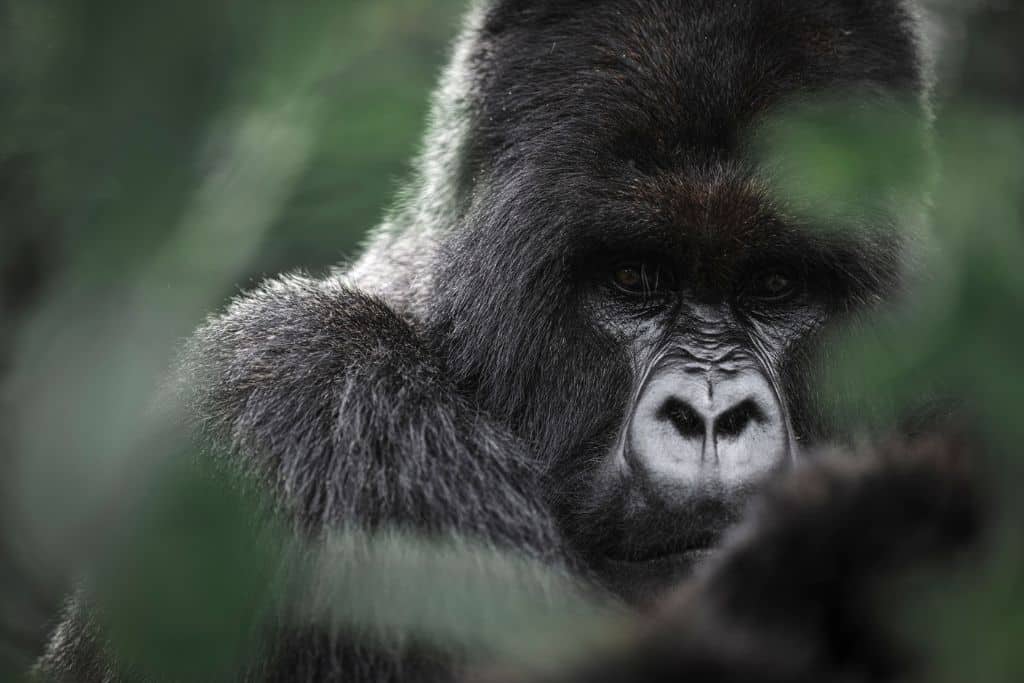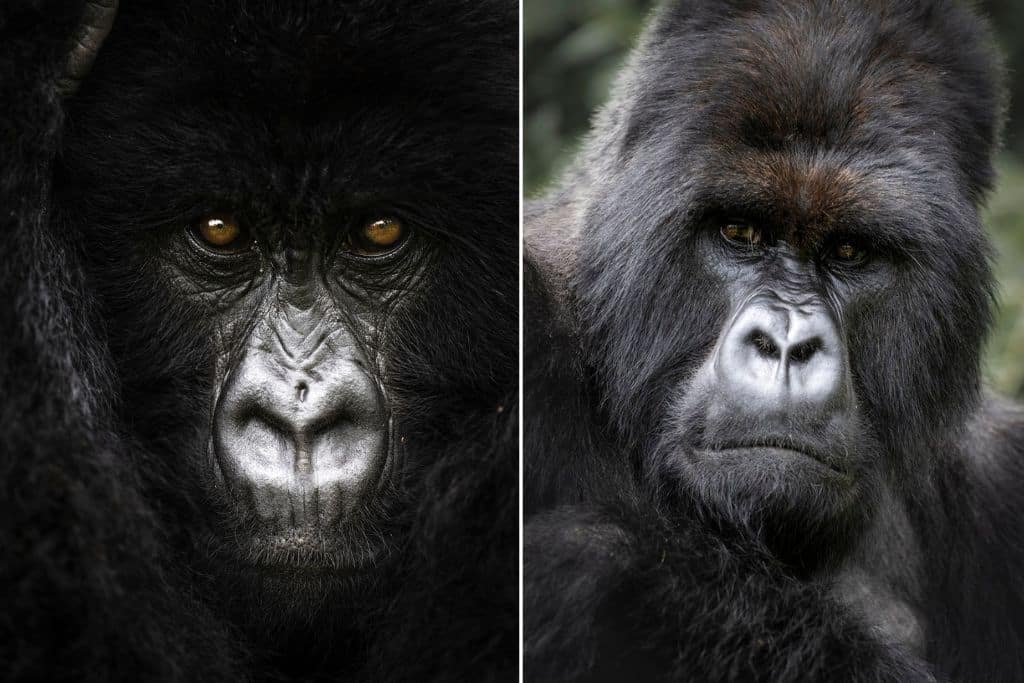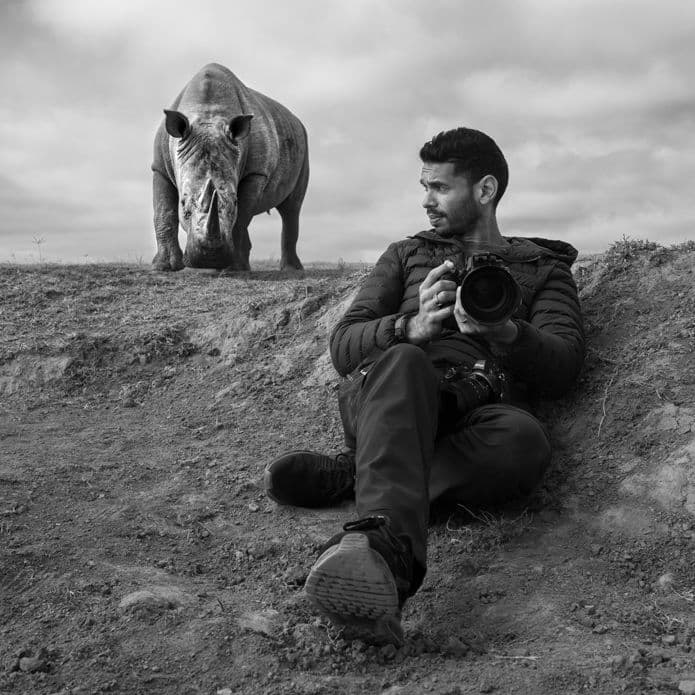Step into Rwanda’s vast Volcanoes National Park through the lens of Zambia-raised Earth.Org photographer Amish Chhagan as he documents the last remaining species of Mountain Gorillas. Despite showing signs of a miraculous resurgence, the Mountain Gorilla remains listed as endangered, with roughly 1,000 individuals spotted in a recent count.
—
“When you realise the value of all life, you dwell less on what is past and concentrate more on the preservation of the future.” – Dian Fossey
As we sluggishly made our way to the hotel lobby after a long flight the day before, we found Didier eagerly waiting to take us on a cross-country trip to the Volcanoes National Park. His ear-to-ear smile caught our attention and he quickly approached us like we were old friends reconnecting after many years. We felt a sense of pride and welcomeness, a belonging, another home far from home.
Back in the 1990s, Rwanda went through one of the most brutal and violent genocides in human history. Growing up in the nearby country of Zambia, there was a general concern that the instability may instigate issues within our own country. I was a kid during the Civil War and clearly did not comprehend what was going on, but there was tension in the air anytime Rwanda was mentioned. I once caught a glimpse of the local news reporting about what was going on – I still have this vivid image of a machete embedded in my mind. Since then, numerous documentaries and movies have depicted what happened; most are extremely painful to watch.



I am not here to relive the details. Instead, I would like to highlight the remarkable progress the country has made since 1994. Today, a mere three decades after the end of the war, Rwanda is regarded as one of the safest, cleanest, and most business friendly countries in Africa. In 2021, a formidable report by the Rand Merchant Bank (RMB), Where to Invest in Africa, ranked Rwanda fourth in investment attractiveness.
Few countries in Africa boast such progress in multiple thematic areas – strength of economy, low poverty levels, zero corruption and crime, a thriving and forward-thinking education system, ecotourism, conservation – the list goes on.
While I have spent most of my life in Zambia, my work took me to numerous countries in Africa, even before I became a professional photographer. In this time, no country I have visited or researched has shown this level of progress and advancement, in particular in less than a generation – from a war-stricken country to one of the most thriving countries, not just in Africa, but in the world.
Given my profession as a photographer, supporting conservation (and ecotourism) is part of my mission statement. My role only subsists because the natural world and their inhabitants still exist today, but therein exists an important and mandatory duty in conservation. It is not about me, my creative passion, and my artistic impressions but rather part of an impactful global climate agenda. I am blessed and grateful to be part of this mission, despite the challenging, frustrating, and often painful nature of this journey.
You might also like: Capturing Climate Change: How Photography Can Tell the Story of a Warming World


The more time I spend capturing beautiful moments in the wild, the more I am drawn to documenting endangered species, not only because it is increasingly becoming scarce to photography but also to communicate a powerful message by showcasing the beauty of these magnificent creatures. Unfortunately, that endangered list continues to grow every day.
The Mountain Gorilla, a sub-species of the Eastern Gorilla, is one such example. As the name suggests, they reside in low to mid-range altitudes, found only in what is known as the Virunga Massif, a chain of eight dormant volcanoes at the intersection of Rwanda, Uganda and Congo. They tend to roam around these mountains seeking new territories, shelter, and food, crossing country borders seamlessly – visa free.
Back in the late 1960s, a young and ambitious explorer by the name of Dian Fossey made it her life’s work to study and research Mountain Gorillas. As Jane Goodall made strides with chimpanzees, Fossey made incredible progress in habituating these gorillas and sharing her ground-breaking research on their ethology. Unfortunately, one of her learnings was that poachers were contributing to the rapid decline of the Mountain Gorilla population. Her role quickly turned into one of conservation, using arguably unconventional methods to terrify poachers and creating havoc amongst local communities, the government, and international traders.
Gorilla infants were targeted as demand from zoos around the world wanted to showcase the species. To acquire an infant, poachers would often have to eliminate entire gorilla families. Demand from several countries in Asia paid handsomely for the head, feet or the hand – the latter of which was typically used as a cigar ashtray. It became increasingly difficult to recognise the gorillas that had been killed as the face, hands and feet were key factors in identifying individuals.
You might also like: The Precarious Existence of Critically Endangered Gorillas


To you and me, these types of gruesome stories will surely sicken us and prompt us to question why, maybe even take action. It is not a simple answer – a complex and prosperous supply chain of poached products, the local community’s livelihood, Asian culture for status and traditional beliefs are just a few. I believe it goes deeper than this, touching on the human psyche around power and competition. These traditions have been around for many years, even during the time of hunter gathers, when humans hunted mammoths and other prehistoric animals. It is a practice that has evolved over time and has become one of displaying wealth, power, and status – a social construct we created to show we are at the top of the food chain. All the while, these actions contribute to one of the primary existential threats of not only these species, but our very own existence.
At their low in the early 1980s, there were around 250 Mountain Gorillas in the wild. Thanks to Dian Fossey’s Research Centre, the Rwandan government, and a global conservation effort, populations have risen to over 1,000 today. Across the gorilla subspecies, the Mountain Gorillas are the only species seeing an upward trend in population. Whilst this is most certainly progress, they are still considered endangered despite poaching and habitat destruction no longer a primary threat. The gorillas are closely monitored daily, whether it be trackers sourcing a family for the one-hour visit from tourists or researchers attempting to build relationships with non-habituated gorillas.

The ongoing and future threats to these species are naturally human-wildlife conflicts, as it tends to be across Africa and other parts of the world that maintain terrestrial areas. As human populations continue to grow, including the surrounding local communities, demand for more land to be used for agriculture and shelter will inevitably increase. Tackling this before it crosses a point of no return is now a job for the government; and as with most other thematic areas, the Rwandan government is already making progress.
In partnership with ecotourism operators such as Wilderness Destinations, the government has developed plans to expand the Volcanoes National Park. The plan involves offering local communities an incentivised relocation program, which includes building new homes and providing access to key agricultural tools.
The night before our gorilla trek, I barely slept. I woke up several times thinking it was time to get my gear on. The Bisate Lodge setting was already teasing us as to what will come of this trip; a mini uphill trek to our “nest”, sights of the Bisoke and Karisimbi volcano peaks rising through the forests, and the symptoms of heavy breathing and coolness due to the high altitudes.
The camp was exquisite, blending luxury with an African twist and homely feel. There are only six rooms – well, more like an open plan one-bedroom penthouse. The views of the volcano mountains in the distance gave the eyes space to breathe. The aroma of fresh crisp air gave you a small adrenaline high as it reminded you of where you were. Every little detail seemed to have been thought of.

I have always valued client service; it is the factor that distinguishes good hospitality from great. Whether at my local coffee shop, barber, or a camp in Africa, those I have fond memories of made an effort in building a relationship with us. Our experience at Bistate Lodge was most definitely one of those fond memories. All the staff knew our names and backgrounds before we even stepped foot at camp. Not only were most of the staff from the surrounding communities, but it almost seemed they were hand-picked with the criteria of a glowing warm orange energy. In hindsight, our encounters with Rwandans throughout our trip were charming and engaging.
On the morning of our gorilla trek, I was woken by the aroma of freshly brewed coffee. The rich scent filled the air, instantly energising me for the adventure ahead. As I sipped the steaming cup, I couldn’t help but feel a mix of excitement and anticipation, with a hint of nervousness. I was about to witness the Mountain Gorilla in person. We gathered our gear and set off into the dense jungle, guided by experienced trackers and rangers.
The family we were going to meet was the Suza family consisting of about 20 members with three silverbacks, several blackbucks, and a couple of babies. We were informed that our estimated time of arrival to the gorilla family’s location was about 30-45 minutes, but as we approached the half hour mark, we were informed the gorillas had moved further north. We adjusted our course and continued deeper into the dense foliage, our anticipation growing with each step. The sounds of rustling leaves and distant calls of birds enveloped us, creating an otherworldly atmosphere. Finally, after what felt like an eternity, we caught a glimpse of black fur through the trees. We placed our masks over our faces, got my cameras out and approached cautiously.
The gorillas seemed unperturbed by our presence, as if they were allowing us a glimpse into their world. The expressions on their faces spoke volumes – wisdom, curiosity, and a deep connection with each other. Their tranquil demeanour conveyed a sense of peace and acceptance. It was as if we had entered a sacred sanctuary, where humans and gorillas coexisted harmoniously. With each click of my camera’s shutter, I felt a surge of excitement, realising the significance of documenting these incredible creatures.
The similarities of these species to us are un-canning – unsurprisingly, considering that there is only a 1.6% difference in DNA between humans and gorillas. The obvious features are hands, opposable thumbs, ears, teeth structure and facial composition. Females have a similar pregnancy period of around 8.5 months, with mothers and other female family members taking care of their offspring as we would. What struck me the most was their mannerisms – their facial expressions clearly show their emotion, whether calm, annoyed, playful or curious.

The behaviour between them was dependent on how strong the relationships with each other were; again, much like us humans. Brothers, sisters, and mothers clearly showed protection for their curious infant, who kept creeping closer to me as it saw his reflection on my lens. There was a particular blackback that was not even allowed close to where the family was resting. Every time he took a step closer, one of the silverbacks grunted aggressively, communicating to stay away – the ranger explained it could have been something he did to upset the silverback and this was his punishment.
Toward the end of our visit, it started to drizzle, and the main silverback of the family went from a relaxed state to becoming very grumpy, arms crossed and frowning, visibly upset. We were protected well with all our waterproof gear, but it was yet another moment when our parallels with gorillas surfaced once more. We were in an open area, hence no protection for him and his family. He looked up at the sky as if to ask why and then looked directly at me as if to demand for my raincoat. Those five seconds felt like an hour and gave me heart palpitations. What a way to say goodbye.
We took the opportunity to visit yet another primate species, the golden monkey. These unique and rare species are primarily found in the Virunga Mountains at the intersection of Rwanda, Uganda and the Democratic Republic of Congo (DRC).
Golden monkeys are considered endangered and, although no official statistics exist on population, it is estimated there are between 4,000-5,000 remaining in the forests of the Virunga Mountains, with populations in decline due to habitat destruction. They are insufficiently explored, unlike other primates such as the mountain gorillas and chimpanzees that reside in similar habitats. The Dian Fossey Centre is one of the only organisations that have created a team specific to researching these species and have been doing this over the last 15 years, making great strides in understanding their ethology. The idea was to replicate a similar approach to one that Dian Fossey applied to the mountain gorillas using trackers and researchers, all the while habituating them and creating a conservation model that will assist in recovering the species.
There are few experiences in my life that have taken me by awe than being in the presence of one of humanity’s closest ancestors. It is almost as if we were witnessing a time before human settlements. Those of us lucky enough to have witnessed mountain gorillas in their habitat will surely understand how fortunate and lucky we are. In the few years since I have embarked on the journey of conservation and wildlife photography, this has been the pinnacle. That is not to say my other adventures have not been special. This one took me on an unexpected emotional journey – one with gratitude, joy, and thrill but also with sadness and shame as the conservationist in me kicks in because of the destruction we have caused, not only for these gorillas, but for the wider biodiversity.
Article and photos: Chags Photography by Amish Chhagan
For more Earth.Org photo stories, click here
This story is funded by readers like you
Our non-profit newsroom provides climate coverage free of charge and advertising. Your one-off or monthly donations play a crucial role in supporting our operations, expanding our reach, and maintaining our editorial independence.
About EO | Mission Statement | Impact & Reach | Write for us


















